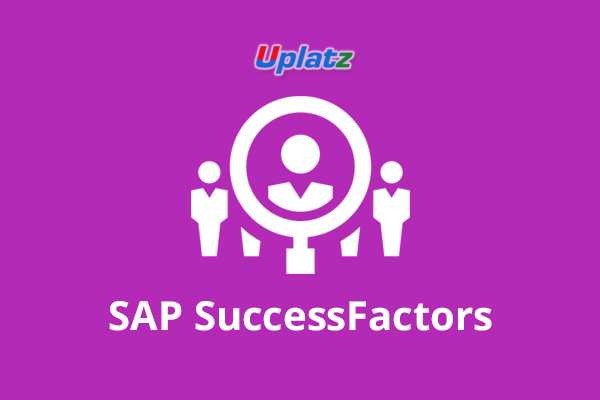SAP US Payroll
Specialize in United States Payroll structure, system, its configuration, management, and processing of payroll records.Preview SAP US Payroll course
View Course Curriculum Price Match Guarantee Full Lifetime Access Access on any Device Technical Support Secure Checkout Course Completion Certificate 81% Started a new career
BUY THIS COURSE (GBP 29)
81% Started a new career
BUY THIS COURSE (GBP 29)
-
 93% Got a pay increase and promotion
93% Got a pay increase and promotion
Students also bought -
-

- SAP SuccessFactors Employee Central
- 10 Hours
- GBP 29
- 2122 Learners
-

- SAP HCM Payroll
- 4 Hours
- GBP 29
- 121 Learners
-

- SAP UK Payroll (basic to advanced)
- 20 Hours
- GBP 29
- 123 Learners

The SAP US Payroll module component allows you to process payroll for employees in the United States, using data from SAP Personnel Administration and Benefits under a wide variety of configurations. You can also run payroll using a combination of SAP and third party products. The SAP Payroll system also offers a number of standard payroll reports. The Tax Reporter component allows you to generate all required state and federal tax forms, such as SUI reports and W-2s. Further reports can be generated using Ad Hoc Query in conjunction with an SAP Payroll Infotype.
United States Payroll should be implemented in cooperation with the project team implementing other areas of SAP HR, particularly Personnel Administration. Since US Payroll uses an interface to a separate BSI TaxFactory database to calculate taxes, you need to consult with networking, database and Basis personnel during some parts of the implementation.
The Payroll component is integrated with other SAP HR components, such as Personnel Administration and Benefits. There are also interfaces to other SAP modules such as Financial Accounting and Controlling.
SAP Payroll allows American businesses to run payroll for employees in all states. Requisite statutory reports, such as Federal forms 940, W-2, W-3, and all state SUI forms are also supported by the SAP system.
SAP U.S. Payroll Tax Calculation by BSI is a required addition to any U.S. Payroll license or subscription. The U.S. has complex regulations and compliance requirements with respect to payroll taxes and these undergo frequent changes. With an integrated SAP payroll/ BSI solution, SAP eliminates for its customers the burden of tracking regulatory rules and ensures compliance with tax regulations.
Important features of SAP HCM US Payroll are as follows:
• Time data from Time Management is included in Payroll and is used during the payroll run.
• Data retention allows you to use master data and other payroll related data from Personnel Administration.
• Payroll can be integrated with Personnel administration, time management, wages and accounting.
• Incentive Wages component is used to process payroll directly.
Expenses and payable information from SAP Payroll component is posted directly in Financial Accounting FICO to assign a cost center for all the costs.
SAP Payroll system also calculates the gross pay and the net pay. It consists of payments for each employee and deductions made during a payroll period. All payments and deductions are included in the remuneration calculation using different wage types.
This SAP US Payroll training by Uplatz provides in-depth coverage of US Payroll system, its configuration and management, and processing of payroll records. This SAP HCM US Payroll course will help you specialize in United States Payroll structure and will assist you in building your profile as SAP HCM US Payroll Consultant.
Course/Topic - SAP US Payroll - all lectures
-
In this lecture session we learn about basic play in SAP US payroll and also talk about two main categories.
-
In this lecture session we learn about the payscale process and also talk about features of payroll drivers in brief.
-
In this lecture session we learn about payroll schema in SAP US payroll and also talk about features of payroll control record in brief.
-
In this lecture session we learn about additional payments in brief and also talk about payments and deduction in brief.
-
In these lecture sessions we learn about how we maintain HR master record and also talk about features of change in residence tax area.
-
In this lecture session we learn about posting FI in SAP US payroll and also talk about features of posting FI in brief.
-
In this lecture session we learn about flexi work schedule and time management in SAP US payroll.
-
In this lecture session we learn about absences and counting rules in SAP US payroll and also talk about features of absences counting.
-
In this lecture session we learn about time evaluation for absences in SAP us payroll and also talk about features of time evaluation for absences.
-
In this lecture session we learn about attendance time evaluation and also talk about different types of drivers.
-
In this lecture session we learn about benefits management USA in brief and also talk about features of benefits management USA.
-
In this lecture session we learn about benefits for medical in SAP US payroll and also talk about features of benefits for medicals.
-
In this lecture session we learn about benefits wage and types and enrollment in SAP US payroll and also talk about function of benefits wages.
-
In this lecture session we learn about insurance benefits plans and also talk about features of insurance benefits plans.
-
In this lecture session we learn about LSMW master data management and also talk about features of LSMW master data management.
By the end of this SAP US Payroll training you will:
1. Acquire the relevant knowledge required to clear the SAP certification exam
2. Understand the core concepts of SAP US Payroll module
3. Be able to apply the knowledge learned to progress in your career as SAP US Payroll consultant
4. Payroll Fundamentals
SAP US Payroll- Course Syllabus
SAP– HCM
Introduction of SAP
● Introduction of SAP
● Role of SAP
● SAP Landscape
● SAP projects Types
● SAP versions
● SAP modules
● Types of Implementations
HR Structure
● Introduction
● Defining a Company
● Company Code
● Personnel Area
● Personnel Sub Area
● Assigning Enterprise Structure
Personnel Structure
● Introduction
● Defining Personnel Structure
● Employee Groups
● Employee Subgroups
● Payroll area
● Assigning Personnel Structure
Personnel Administration:
● Introduction
● Basic Settings
● Maintaining number range intervals for Personnel Numbers
● Determine defaults for number range
● Organizational Data
● Define Administrator Groups
● Define Administrator
● Define employee Attributes
● Customizing Info type menu
● Customizing Personnel Actions
● Define Info group
● Set up Personnel Actions
● Create reasons for Personnel Actions
● Change action menu
Organization Management
Reporting structure Methods:
● Organization & staffing
● Expert mode
● Simple maintenance
● General structure
● Info types
Organization structure:
● Introduction
● Defining Organization Structure
● Evolution path
● Organization Units
● Positions
● Person
● Job
● Tasks
Recruitment
● Introduction
● Basic Settings
● Set up integration with other components
● Create number ranges for applicant numbers
● Workforce requirement and advertising
● Create positions, media, recruitment instruments
● Applicant Administration
● Create Personnel Officer
Applicant Structure
● Maintain Advertisement, Vacancy
● Selection Procedure
● Unsolicited applicant group
● Applicant Master Data
● Applicant Activity
● Maintain applicant activity
● Transfer applicant data
Maintaining of Master Data (PA)
0003 Payroll Status
0006 Addresses
0007 Planned Working Time
0008 Basic Pay---------------- SALARY
0009 Bank Details
0014 Recurring Payments/Deductions -----
0015 Additional Payments--------------------BONUS
0016 Contract Elements
0019 Mointoring of Tasks
0023 Other/Previous Employers
0031 Reference Personnel Numbers
0032 Internal Data
0040 Objects on Loan
0041 Date Specifications
0045 Loans
0065 TAX
0069 NATIONAL INSURANCE
0070 COURT ORDERS
0071 pENSION
Time Management
● Introduction
● Define Work Schedules
● Define Public Holiday Class
● Define Daily Work Schedules with breaks
● Define Period Work Schedule
● Set Work Schedules Rules & Work Schedules
● Generate Work Schedule manually
● Set default value for the Work Schedule
●
● Time Data Recording and Administration
● Defining Attendances, Absences
● Define Absences/Attendances Counting by Counting rule
● Managing Time Accounts using Attendance/Absence Quota
● Setting Groupings for Time Quotas
● Defining Attendances & Absences Quota
● Rules for generating Quotas
● Quota Deduction using Attendances/Absences
● Defining of Deduction Rule
● Assigning of Deduction Rule to Counting Rule
● Time Evaluation settings
PAYROLL MANAGEMENT:
● Introduction
● Payroll area and control records
● Remuneration Structure
● Defining Pay Scale Type and Area
● Assigning Pay Scale Structure to Enterprise Structure
● Determine Defaults for Pay Scale Data
● Revise Pay Scale Groups and Levels
● Define Pay Scale Salary Ranges
● Wage type Structure
● Create Wage Type Catalogue
● Check Wage Type Catalogue
● Default Wage Type
● Payroll Organization
● Define Period Parameters, Date Modifiers
● Check Payroll Area
● Generate Payroll Periods
● Maintaining of payroll related info types
● Maintaining 0008, 0003 and Country Specific tax related Info types
● Execute payroll run for an employee and successfully exit from payroll run
● Subsequent Activities
Benefits
● Benefit areas and benefit providers
● Define parameter groupings
● Benefit plans (Health , Insurance, Savings)
● Benefit Plan Types
● Plans Status
● Benefits integration with payroll
● Benefits integration with personnel administration
Taxation us country
Us country specific tations
The SAP US Payroll Certification ensures you know planning, production and measurement techniques needed to stand out from the competition.
SAP SuccessFactors Employee Central Payroll is SAP's payroll software. The software unifies global payroll management and administration on a single platform for more accurate and compliant processing.
SAP HR software includes payroll management, administration, and processing through SAP SuccessFactors Employee Central Payroll. The cloud solution can integrate with other human resources and enterprise processes.
SAP program is a sequence of instructions written in the special programming language called ABAP that control behavior of a computer for recording business transactions and performing various analytics functions. When an SAP program is being executed, it delivers certain business functions to users of an SAP system.
Uplatz online training guarantees the participants to successfully go through the SAP US Payroll Certification provided by Uplatz. Uplatz provides appropriate teaching and expertise training to equip the participants for implementing the learnt concepts in an organization.
Course Completion Certificate will be awarded by Uplatz upon successful completion of the SAP US Payroll online course.
The SAP US Payroll draws an average salary of $113,000 per year depending on their knowledge and hands-on experience.
What is payroll accounting in SAP?
Payroll accounting is an extension (add-on) to SAP Business One for accounting and managing HR data. The payroll accounting system was specially designed to be used in small and medium-sized retail, industry, and service companies.
Our cloud payroll management system simplifies global payroll processes, so you can pay employees accurately and on time.
Note that salaries are generally higher at large companies rather than small ones. Your salary will also differ based on the market you work in.
SAP SF / HCM – Manager.
Payroll Analyst.
SAP HCM Consultant.
1. What Is Period Parameter In Systems, Applications And Products In Data Processing (sap) Payroll?
Answer :
In SAP payroll, the period parameter specifies the time period for which salary is calculated, such as monthly, bi-monthly, weekly, or annually.
2. What Is A Date Modifier?
Answer :
Date modifiers are used to define several payment dates for various payroll areas for which the same period parameter is assigned.
The following table shows the various date modifiers:
Date Modifier Description
1. Payment date on 1st day of the month
2. Payment date on 15th day of the month
3. Payment date on 25th day of the month
3. What Is The Payroll Control Record?
Answer :
payroll control record is a control indicator that controls individual stages of a payroll. It defines the current payroll period and payroll past for retroactive accounting.
4. What Is The Use Of Payroll Areas?
Answer :
The payroll area fulfills the following two functions that are necessary for a payroll:
4. Groups the personnel numbers together, which are to be processed on the same date.
5. Determines the exact payroll period.
5. What Are Payroll Periods?
Answer :
Payroll periods are generated for every combination of period parameter and date modifier that are assigned to a payroll area. These are always defined within a specified time interval.
6. List The Steps Involved In Creating A Payroll Results Infotype (it 0402).?
Answer :
Following are the steps required to create a Payroll Results Infotype:
6. Define the evaluation wage types
7. Set up the Payroll Infotype Assignment, which is used to write the payroll data automatically
8. Assign the evaluation wage types to one or more wage types from the payroll results
9. Assign the evaluation wage types to Payroll Results Infotype
7. What Is Primary Wage Type?
Answer :
The primary or dialog wage types are defined based on the requirement of the organization. They are the standard wage types defined by SAP and start with a number, such as 1012.
8. What Are The Two Main Categories Of Wage Types?
Answer :
The two main categories of wage types are primary or dialog wage type and secondary or technical wage type.
9. What Are Wage Types In The Sap System?
Answer :
The wage types are used to assign the payments and deductions in the employee's payroll. It is also used to control the payroll program.
10. What Is The Use Of Pay Scale Group And Pay Scale Level?
Answer :
The pay scale group schedules the job evaluations and indirect evaluations. The pay scale groups are divided into pay scale levels, which are used to define the level of jobs.
11. What Are Pay Scale Areas?
Answer :
The pay scale areas represent the geographical regions to which a pay scale or Collective Agreement Provision applies.
12. What Is The Pay Scale Type?
Answer :
The pay scale types are two-character keys defined for each region.
13. What Is The Tarif Feature?
Answer :
The standard system contains the TARIF feature, which takes the default values from the pay scale type and pay scale area assigned to the personnel area.
14. What Is The Pay Scale Structure?
Answer :
The pay scale structure comprises the following four elements:
10. Pay scale type
11. Pay scale area
12. Pay scale group
13. Pay scale level
15. What Is Employee Subgroup Grouping For Personnel Calculation Rule?
Answer :
The employee subgroup grouping for personnel calculation rule is defined as a division of employee subgroups, and for these subgroups the same personnel calculation rules are defined for payroll accounting and evaluation in payroll.









